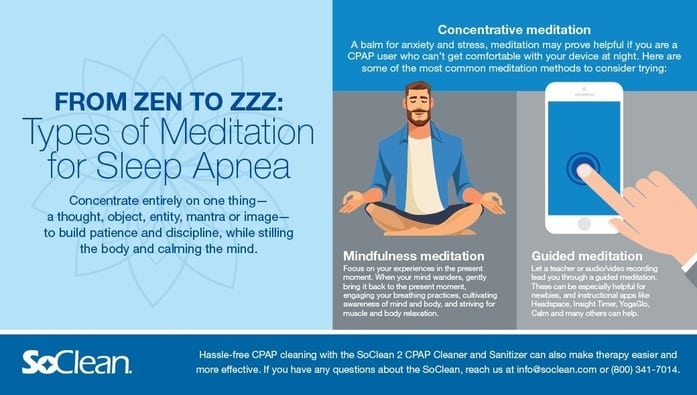
A good night's sleep is an enigma to far too many—and yet essential to optimal wellness. One in four Americans develops insomnia each year, which is why an entire industry has sprung up around tools to help people sleep. The good news is that one of the most helpful methods—meditation—doesn't have to cost you a thing. Meditation has been around for thousands of years in cultures across the globe. But now more than ever there are incredible resources, backed by heaps of neuroscientific research, at your fingertips and ready to guide you in relaxation meditations.
For obstructive sleep apnea (OSA) sufferers, the need for good, consistent sleep is even greater, as the nearly 1 billion estimated OSA sufferers have extra hurdles to jump when counting sheep. Though continuous positive airway pressure (CPAP) therapy is the most prescribed and effective treatment for OSA, long-term compliance rates remain historically low. One analysis found these to be among the most common reasons for therapy noncompliance: the noise of the CPAP machine, discomfort with the mask or a sense of ‘claustrophobia' with the apparatus. Even the in-lab sleep studies that serve as a precursor for OSA diagnosis can be stressful for patients. In other words, in spite of the demonstrated benefits of using a CPAP device, the anxieties patients feel around it have proven to be a real barrier to both a good night of sleep and adherence to their therapy.
Designed as a balm for anxiety and stress, meditation may prove helpful if you are a CPAP user who can't quite get comfortable with the device at night. When scientists from Keck Medicine of USC and UCLA conducted a study of 49 older adults, they found that those who participated in a group-based mindfulness meditation program reported better outcomes than those enrolled in a group-based sleep hygiene program.
David Black, an author of the study and director of the American Mindfulness Research Association, said, "Meditation appears to have clinical importance by serving to reduce sleep problems among the growing population of older adults, and this effect on sleep appears to carry over into reducing daytime fatigue and depression symptoms."
Here are some of the central tenants of meditation and the best tips.
What is meditation?
Meditation is a means of transforming the mind, a way to alter your consciousness, and a set of techniques that encourage heightened awareness and attention. That said, what is it?
According to a Harvard Business Journal piece, meditation is about "focusing on your breathing and then bringing your mind's attention to the present without drifting into concerns about the past or future. It helps you break the train of your everyday thoughts to evoke the relaxation response, using whatever technique feels right to you."
It all begins with concentrating on your breath. As Jon Kabat-Zinn writes in his book "Mindfulness for Beginners," "Our breathing can serve as a convenient first object of attention to bring us back into the present moment, because we are only breathing now—the last breath is gone, the next one hasn't come yet—it is always a matter of this one. So it is an ideal anchor for our wayward attention. It keeps us in the present moment. … Paying attention to the sensations of breathing in the body serves as the first object of attention for beginning students in many different meditative traditions. "
How to get a better night of sleep:
There's no one-size-fits-all meditation to get you to sleep at night. But here are some of the most common meditation methods to consider trying:
Concentrative meditation: The goal of this form of meditation is to concentrate entirely on one thing: a thought, object, entity, mantra or image (e.g., a candle flame, a peaceful scene). This type of meditation is an important part of Buddhist teachings—and of many spiritual practices—and is said to build patience and discipline, while stilling the body and calming the mind.
Mindfulness meditation: Mindfulness meditation is a form of meditation in which you focus on your experiences in the present moment. When your mind wanders and begins to chatter at you, you are to gently bring it back to the present moment, engaging your breathing practices, cultivating awareness of your mind and body, and striving for muscle and body relaxation. This can be achieved even through 15 minutes of journaling a day. To learn more about this form of meditation, join a Mindfulness-Based Stress Reduction (MBSR) program, developed by Kabat-Zinn, at a university or hospital near you.
Guided meditation: Meditations that are led by a teacher or audio/video recording are called guided meditations. These can be especially helpful for those who are new to meditation, and there are more resources available than ever, including instructional meditation apps like Headspace, Insight Timer, YogaGlo, Calm and many others. One form of guided meditation, called yoga nidra (also referred to as "yogic sleep" or "psychic sleep"), helps you reach the "hypnagogic state," which is the space between sleep and wakefulness. It is said to be more restful than sleep itself. For most of us, this state lasts a mere three and five minutes, but the goal of yoga nidra is to keep you in it for 45 minutes to an hour.
Before trying meditation to fall asleep at night, experts recommend practicing meditation for 20 minutes each day. Not only will this allow you to "get the hang" of meditation, but meditating several times throughout the day will also keep stress levels low so you can sleep better.
And hassle-free CPAP cleaning with the SoClean 2 CPAP Cleaner and Sanitizer can make therapy easier and more effective. If you have any questions about the SoClean, please reach us at info@soclean.com or (800) 341-7014.